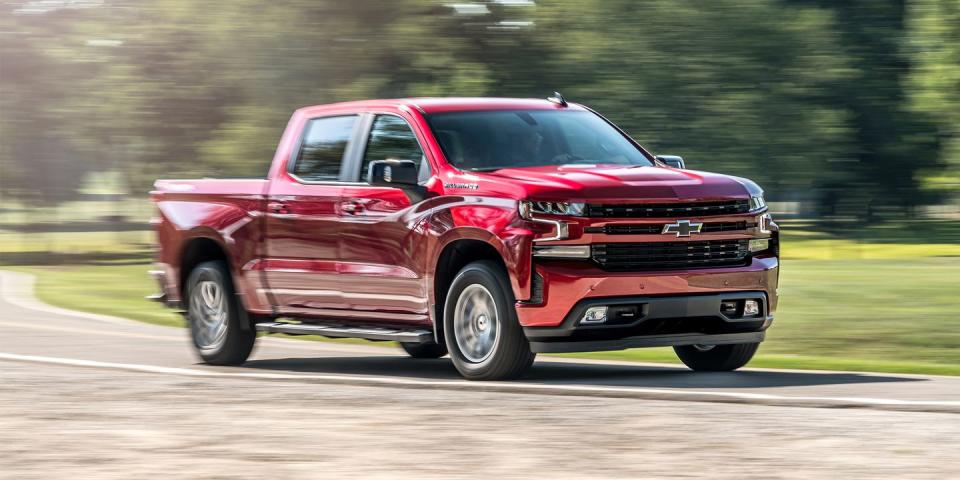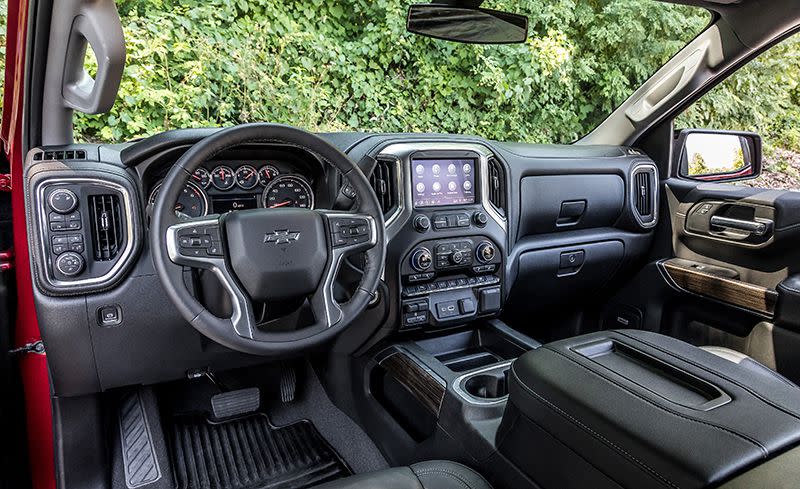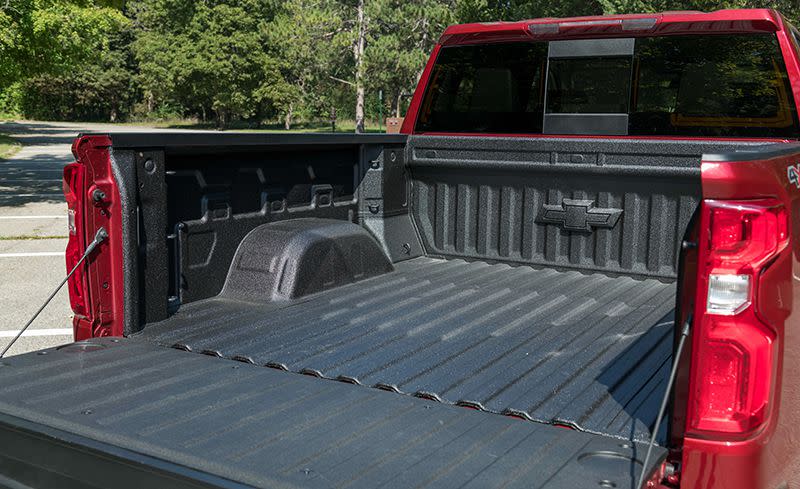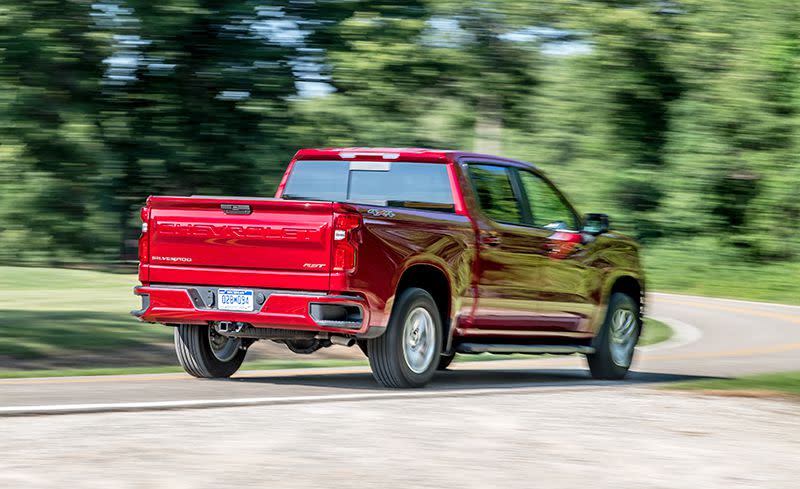The 2019 Chevrolet Silverado 1500: Number Two Tries Harder

There's no disputing the full-size pickup truck's place at the top of the vehicle-sales food chain. Together, Ford, General Motors, and Ram sold about 2.2 million of the things in the U.S. last year. Also-rans Nissan and Toyota added just shy of 170,000 more to that count, making it so that full-size trucks now account for almost 14 percent of the U.S. vehicle market. What is in dispute-and it's a hot dispute, one waged almost incessantly in TV commercials and on discourteous bumper stickers-is which truck is the best truck, King of Kings, Lord of the Contractor, Protector of the Suburban Man with Something to Prove.
With some 897,000 examples sold here in 2017, the Ford F-series holds the title for now. The Silverado's 586,000 sales may not look like much of a threat to Ford's numbers, but with the GMC Sierra's sales added in, that figure climbs to 804,000. And wherever there's a crown to win, a challenger dreams of wearing it.
The new Silverado is bigger yet lighter than the outgoing model. The entry-level 4.3-liter V-6 is unchanged, but there are two new engines: a 3.0-liter turbo-diesel, coming early next year, and a 310-hp turbocharged 2.7-liter inline-four, due in showrooms in December. Both existing V-8s now feature Chevy's new Dynamic Fuel Management (DFM) technology, which improves on the Active Fuel Management (AFM) cylinder-deactivation system by employing 17 different firing modes and shutting down as many as six cylinders depending on the driver's demand for torque. DFM operates almost entirely under the radar, thanks to the efforts of development engineers who programmed parameters for each firing order to avoid unpleasant NVH. In our testing, the 5.3-liter eight-speed Silverado tied a similarly equipped 5.0-liter 10-speed F-150 at 16 mpg. A 5.7-liter Ram 1500 without the fancy eTorque 48-volt hybrid system achieved 14 mpg.
The Silverado's transmission lineup is now nearly as diverse as its engine roster. The standard 4.3-liter V-6 and the 5.3-liter V-8 with AFM still pair with a six-speed automatic, while the 5.3 equipped with the new DFM technology uses an eight-speed auto, as will the four-cylinder when it becomes available. The 6.2-liter and forthcoming 3.0-liter turbo-diesel come with a 10-speed automatic that GM shares with Ford. A single-speed transfer case is the new standard for all-wheel-drive models, though the truck's available Z71 Off-Road package-standard on Trail Boss models-adds back a low range. Every all-wheel-drive Silverado now has push-button electronic controls to manage the system (some base and near-base models used to have floor-mounted shifters for this purpose).
One of the chief criticisms of the outgoing truck was that it looked too much like its predecessor, to the extent that even the truck-savvy couldn't tell the two apart. Perhaps Chevy had taken the whole "if it ain't broke, don't fix it" thing a little too far. So Chevy stamps the new truck's sheetmetal with sleeker lines in the hood and around the wheel wells, and a multilevel headlight array modernizes the Silverado's face. We're not sure Chevy nailed it this time, either; at a traffic light, one fellow motorist leaned out his window to call the Silverado feminine-well, okay, that wasn't the word he used.
Non-cosmetic tweaks to the exterior had a more positive effect. Chevy claims short-bed variants of the V-8 Silverado lose 450 pounds compared with the last generation, largely due to a new manufacturing strategy that allows GM to construct the body and frame from several different grades of steel and the doors, hood, and tailgate from aluminum. Varying the thickness of steel over different parts of the frame makes the Silverado lighter without relying on an expensive aluminum-intensive construction, as Ford does. Payload and tow ratings are up by a few hundred pounds for some models, and the Silverado's new bed is constructed in three pieces, which allows the wheel wells to be stamped differently, increasing cargo volume to 63 cubic feet in short-bed models. Compare that with the Ram 1500's bed at 54 cubic feet and the F-150's at 53 cubic feet, and things are starting to look good for Chevy's usurper.
Those numbers are big news for the contractors and weekend warriors who rely on their trucks to get big jobs done, but plenty of truck owners treat their workhorses more like show ponies. So Chevrolet aimed to build a truck that would ride well even when it's unladen, and during our initial drive on Wyoming's well-maintained roads, the Silverado seemed to fulfill that goal. It recovers quickly from small bumps, the steering is well weighted and accurate with no dead zones, and overall it feels surprisingly agile on meandering mountain passes. In Michigan, though, the 5.3-liter all-wheel-drive crew cab we tested occasionally became unsettled over blighted roadways, especially when traveling at freeway speeds.
One point for the Midwest, though: While climbing the foothills around Wyoming's Tetons above 6000 feet, the 355-hp 5.3-liter failed to express its full power, and the eight-speed automatic sometimes lagged when going uphill at part throttle, downshifting several seconds after a human would have. Back in our flatland home, however, our RST model sprang to 60 mph in 6.1 seconds. That's a respectable pace even for a vehicle that doesn't weigh two and a half tons, but it's not enough for a victory in the truck wars.
The RST trim level is new for 2019 and is essentially a performance-appearance package with black bow-tie badges; LED head-, fog-, and taillights; and body-colored moldings in place of the showy chrome that adorns LTZ and High Country models. Starting at $45,995, an all-wheel-drive crew-cab RST leaves a lot of amenities on the table. Our example included options such as dual-zone climate control; heated front seats and steering wheel; two USB ports in the second row; a trailering package with a beefier rear axle, a radiator with more cooling capacity, and revised shock tuning; and active-safety items, such as front and rear parking sensors and blind-spot monitoring. The 5.3-liter was also an upgrade over the turbocharged 2.7-liter four, which will be the standard offering in the RST trim.
Our $56,875 truck felt like anything but a bargain, with interior trim materials that fail to justify such a price tag. Even High Country models leave something to be desired. This may be to make room in the General's quiver for the Sierra or to maximize an already massive profit margin; whatever the case, when it comes to interiors, Ford and Ram outclass Chevy.
Between the diet, the DFM system, and the forthcoming diesel and four-cylinder engines, the Silverado is on track to match the F-150's fuel economy, and GM expects to undercut Ford in manufacturing costs. The Silverado may not be quicker or more comfortable than the F-150, but its bigger bed and increased tow ratings will make some customers notice. And if it's able to make more money from each sale than Ford can, GM may be wearing the crown even if the Silverado doesn't sit on the sales throne.
From the November 2018 issue
('You Might Also Like',)

 Yahoo Autos
Yahoo Autos 


